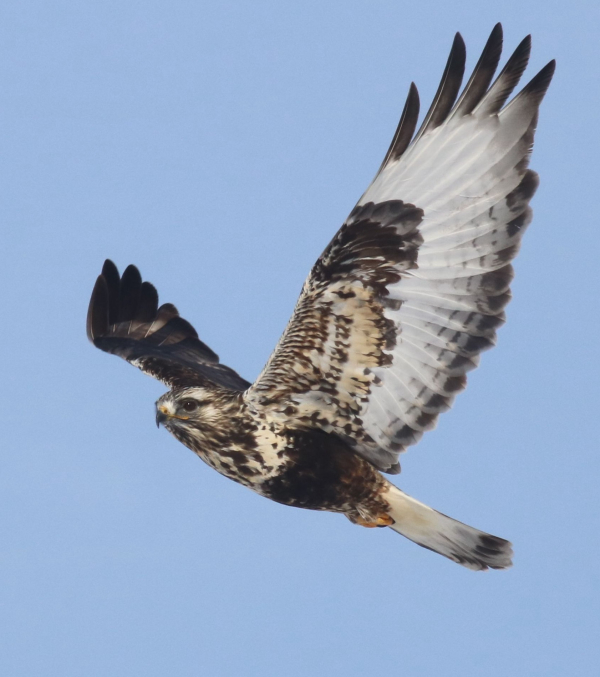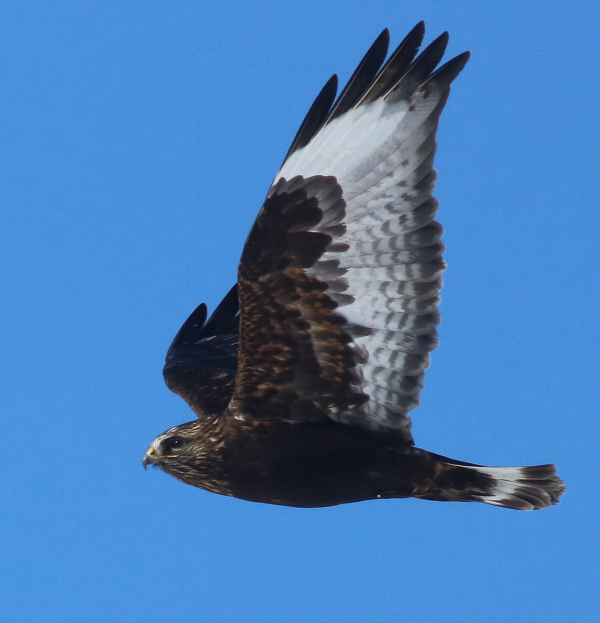 Rough-legged Hawks continued to be the most likely wintering birds to encounter in the open plains, along with an occasional Bald Eagle.
 A stunning black morph Rough-legged Hawk provided 2 sightings a week apart, each with photo opportunities as part of the observations.
 During an early January visit to Wheeler National Wildlife Refuge in northern Alabama, the steady approach of a foraging Whooping Crane provided many visitors with a closer look at the rare bird among Sandhill Cranes, while providing an opportunity for a few documentary photos. |
Seasonal breakthroughs open our minds and focus our views, and on the first day of February, 3 impressive birds provided immediate enthusiasm and a new level of excitement. Over the previous week, I had to drive no less than 25 miles to find a bird, but that changed dramatically Thursday only 2 miles from my office. There, standing on the lake ice was a big brown raptor! Binoculars revealed it was a small male first-year Bald Eagle – wonderful. Driving another mile, there was an adult Bald Eagle perched in a tall tree, and 2 miles farther was a hovering hawk, a Rough-legged Hawk!
The Rough-leg provided a half-hour of photo potential, although the direction of the wind kept the hawk perching and hovering with the sun at its back, shadowing its front side most of the time. Nonetheless, I followed its hunting activities and watched it make 4 strikes toward ground-based prey without catching the likely small rodents it targeted.
Eventually, the hawk landed among some taller grass after an unsuccessful hunting strike, and after almost 5 minutes, I left it to its apparent rest period. That resting behavior appears to be a fairly regular part of Rough-legs’ days, and it helps to explain why I see no hawks in one location, but when I return a half-hour later, I see 2 hawks. With that in mind, I try not to hurry past grasslands that are likely to attract Rough-legs or other birds, imagining that there may be raptors that are out of sight.
Back to my birding drive southward: With 3 sightings close to home I had high hopes for more birds, but the now snowless hilly landscape appeared to be pretty empty for the next 18 miles. That’s when I found the second Rough-leg of the day, hovering with its back toward the sun, and me. I followed it from a distance as it continued to hunt, eventually dropping low to perch on a sign post, where it remained as I continued east.
After dropping into the flat Drift Plain, I covered all the locations where Rough-legs were active during the past week without finding a feather. But as I headed back to my office, retracing my route, a Rough-leg I have encountered twice before was present and provided some nice photo opportunities, although I didn’t fare well in taking advantage of when the hawk made its more spectacular turns in flight with the sunlight at its prime. Oh well, that happens.
I had one more location I wanted to check, and from a far distance I saw the flight of a raptor crossing the road ahead. I sped up, not knowing if the bird would perch or continuing flying past the road. Although I hadn’t seen any raptors in this area since an initial dark morph Rough-leg was hunting from a pole perch 7 days earlier. From a distance, I could see a hawk had perched on a pole on the side of the road, so I took a relieved breath and slowed to get within binocular range. Hmm, it was a dark morph Rough-leg, most likely the same hawk I’d seen before, and quite a surprise considering I hadn’t seen it during 2 previous visits to the area.
Even before I was close enough to think about a documentary photo, the black hawk glided almost straight down to the ground as if it was making a hunting strike. I eased up to it and took a couple quick photos as it looked over its shoulder. Black hawks always seem to elevate my excitement level, and they tend to prove to be more wary and harder to photograph, even when I get a closer vantage point. In this case, the hawk was photographable, but it was standing in front of a black soil field covered with short corn stalks, which did nothing to endear the resulting docu-photos for me.
The hawk soon took flight, which gave me a nice photo chance as it winged before me and began to hunt, flying farther and farther afield, hovering a couple times, making one hunting strike, then settling in – apparently to rest – on the edge of wetland vegetation. I waited a while, even checked back 20 minutes later, but didn’t see any further action and called it a day. No other raptors were evident along my return trip, which emphasized how birds and bird sightings are fleeting elements across the environment.
The day before, I covered a much longer route cross-country west to the Missouri River, then north to the capitol city of Bismarck. Along the way, raptors were the only avian features, including 3 widely separated Rough-legged Hawks and an adult Bald Eagle; but I saw no birds along the river road, which really should be the more likely bird zone this time of year. But within 5 miles of Bismarck I began seeing Wild Turkeys in the more wooded areas along Apple Creek and the Missouri bottoms. Flocks numbered 6, 9, and a whopping 105, which is the biggest flock of turkeys I’ve ever seen!
Alabama Re-View
A month ago, bookended on each side of my week in Florida, I spent a couple hours at a favorite birding location in northern Alabama, at Wheeler National Wildlife Refuge. During December and January the area echoes with the sound of thousands of Sandhill Cranes, with a few rare Whooping Cranes scattered among them. Waterfowl are abundant, with White-fronted Geese standing out among Canada Geese, Northern Shovelers, Gadwalls, Mallards, Blue-winged Teal, Ring-billed Ducks, and Lesser Scaup. Snowy Egrets, Great Egrets, Great Blue Herons, and Double-crested Cormorants are scattered along waterways with Black Vultures and Turkey Vultures soaring overhead. Songbirds I rarely get to see included Northern Cardinals, Tufted Titmice, Eastern Bluebirds, and Eastern Phoebes, plus a Red-bellied Woodpecker.
The scattered Whooping Cranes originate from an introduced population that nests in Wisconsin and winters as far south as Wheeler Refuge. While I had an unforgettable experience with a Whooping Crane just 40 feet away during my first trip to Wheeler the previous January, the Whoopers I spotted during these visits were mere white spots in the distance, surrounded by Sandhills. There was 1 Whooper during my first stop, and 2 during my second visit, and during the course of that outing 1 of the Whoopers foraged across a large field to thrill visitors at the wildlife observation building and providing me with a couple documentary photos.
Foggy Birds
Weekend weather was disappointing in that days that were supposed to create record-breaking high temperatures were shrouded by dense fog, preventing any meaningful birding opportunities beyond my bay windows. At the same time, the winter bird action at my feeding station has stagnated again, but the birds that arrive are much appreciated – especially the female Downy and Hairy Woodpeckers, a few House Finches, and the feisty Red-breasted Nuthatches and White-breasted Nuthatches. The fog continued Monday, but I eventually took a quick afternoon drive south, where the chances of crossing paths with birds has been best. I only found that the fog was thicker in open country, so limited my drive to a few miles. I’m excited for my next birding drive tho, which will cross some “new” winter landscapes. I’ll share the birds I see along the way next week, and hope you get some prime birding time in too.
Article and photos by Paul Konrad
Share your bird sightings and photographs at editorstbw2@gmail.com
